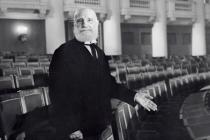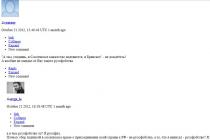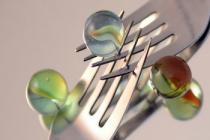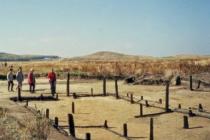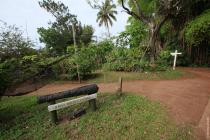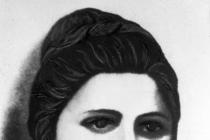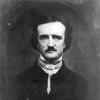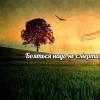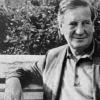Target. Introduce children to the Italian fairy tale “How the donkey stopped singing” (in the arr. J. Rodari). Help children retell short texts without significant gaps and repetitions.
Preliminary work. Ask the music director to tell the children that male singers have different voices - bass, baritone, tenor, and confirm the story with musical fragments.
Lesson progress
“Today I will introduce you to a very clever Italian fairy tale “How the donkey stopped singing” in the processing of Gianni Rodari. We know his fairy tale “Magic Drum”,” the teacher begins the lesson.
The teacher reads or tells a new story.
In ancient times, the donkey, as the fairy tale tells, sang better than the tenor.
Once all the animals gathered in council, and the lion, who was their king, asked:
- Which of you is the most handsome?
- I, ya! the donkey immediately shouted.
- Well, you are the most beautiful.
- And who is the strongest?
- I, ya! - shouted the donkey before the rest of the animals had time to open their mouths.
“All right,” said the lion. - And who is the most stupid here?
- I, ya, ya! the donkey roared in a hurry, frightened lest they overtake him.
All the animals rolled with laughter, and the poor donkey lost his beautiful voice from shame. And since then, he only knows how to roar:
- I, ya, ya!
“Which of you, like me, thinks that this is a very clever and instructive tale? - the teacher continues the conversation. - Can you prove it?
(He monitors the correctness of speech.) And how do you understand the word instructive(story)?
Let's remember what the lion wanted to find out from the animals? (Who is the most beautiful, the strongest and the most stupid.) What happened? It is a pity, of course, that the donkey lost his beautiful voice and since then all donkeys in all countries of the world have been roaring: “Eeyore! Eeyore! Eeyore!“
And what do people call those who behave like a donkey from a fairy tale?
The teacher reads the story again. Then he offers to retell it in person. The teacher chooses the child to play the role of the donkey, and the "donkey" appoints the lion. The teacher tells the story for the author.
Then the retelling is repeated with new performers.
Lesson 7. Working with a story picture
Target. Find out how the children mastered the ability to title the picture and plan the story.
Lesson progress
The teacher offers the attention of children any picture from the series intended for work on the development of speech in kindergarten. Asks what the picture is about and how to title it. At the same time, he reminds that the title of the picture should reflect its content and, if possible, it should be short.
The teacher listens to the answers of the children and invites them to choose the most successful name. If necessary, he gives his own version of the name.
“Imagine that you have to make up a story based on this picture,” the teacher continues the conversation. - Where do you start? Remember that the first phrase can be very embellishing of the story.
Listens to the children's answers and, if necessary, offers his introductory phrase.
Next, the teacher reminds the children that last year they learned to plan a story based on a picture. He is interested in what it is, and offers to draw up a plan for the story. Then evaluates the proposed options (3-4 answers).
“There is an entry, there is a plan. It remains to complete the story with an assessment of the picture as a whole. Who has what options?
The teacher invites one of the children to write a story based on the picture. Then he asks the child if it was easy for him to tell.
The teacher explains to the children that, guided by the plan, it is possible to avoid repetitions and unnecessary words in the story, for example, such as: “and then”, “and also”, “and now”.
"So what did we learn today?" the teacher asks.
At the end of the lesson, he offers to play the game “I conceived an object”.
The teacher guesses an object, and the children, trying to guess it, ask leading questions, for example: “Alive? Inanimate? In room? Outside? Big? Heavy? Made of…"
If there is time left, the teacher can invite the children to guess another subject they have conceived.
Lesson 8. Conversation about A. Pushkin
Target. Tell children about the great Russian poet; cause a feeling of joy from the perception of his poems and a desire to hear other works of the poet.
Lesson progress
The teacher reads to the children 2–3 fragments from the works of A. Pushkin: “A sad time! Charm of the eyes…” (from the poem “Autumn”), “A storm covers the sky with darkness…” (from the poem “Winter Evening”), “A green oak near the seashore…” (from the poem “Ruslan and Lyudmila”). Then he asks the children if they know the author of these poetic lines. And he clarifies: “What do you know about Alexander Sergeevich Pushkin?”
The teacher tells the children about the great Russian poet: “There is no person in our country who would not read the works of Pushkin. Many of you have already heard fairy tales about the priest and his worker Balda, about the dead princess and the seven heroes, about the golden cockerel, about Ruslan and Lyudmila. You will hear these fairy tales more than once, as they are often read on the radio, performances based on them are staged in theaters. Based on the works of Alexander Sergeevich Pushkin, cartoons and films have been created. And very soon you will be able to read these wonderful tales on your own.”
Finishing the lesson, the teacher reads excerpts from "The Tale of the Dead Princess and the Seven Bogatyrs" and "The Tale of Tsar Saltan ..." (at the choice of the children).
October
Lesson 1. Lexico-grammatical exercises
Target. Activate the speech of children.
Lesson progress
The teacher asks the children what time of year it is and what month has replaced September.
“Autumn, autumn,” says the teacher. - And what can you say about autumn - autumn - autumn?
The teacher evaluates the answers of the children, praises the ability to listen to the task and gives his options: autumn bad weather, autumn slush, autumn leaf, autumn mood, etc.
“In autumn, both people and animals stock up for the winter,” reminds the teacher.
The hedgehog went out for a walk
Yes, collect mushrooms.
What mushrooms do you think he got?
Many words have related words, for example: hedgehog - hedgehog ... ( hedgehog - hedgehog - hedgehog - hedgehog)».
Then the teacher invites the children to complete the exercise “One - many”: “There is one heron, but there are many ... (herons), one pack of sugar, but a lot ... (packs), one sock, but a lot ... (socks), one stocking, but a lot ... (stocking), one ear, but many ... (ears).
“Now help me finish the sentences,” the teacher asks:
- If we are attentive in the classes on the development of speech, then ...
To study well, one must...
We grow up healthy and strong because...
“When we get back from the walk, then…”
After listening to the children's answers, the teacher repeats the full sentence.
The teacher invites the children to listen to the poem:
I tried different drinks
I drank golden juices with a full bowl.
They - I do not detract - are excellent,
But pale in comparison with yogurt.
A. Smirnov
“What kind of drinks do you prefer? the teacher asks. Prefers means... (chooses from many others, loves)».
Lesson 2. Memorizing A. Fet's poem "The swallows are gone ..."
Target. Help children remember A. Fet's poem "The swallows are gone ...".
Lesson progress
“We live in Russia, a country with a huge territory. I flew all day from Moscow to Khabarovsk. If I had traveled by train, I would have spent seven or eight days on the road, that is, a whole week. and climatic conditions in different regions countries are different. Somewhere in the south it is still hot, but in the north it is already snowing. And we have?
Each territory has its own autumn signs. But there are also common ones. Sooner or later, they will announce themselves. As in this beautiful poem by the wonderful Russian poet Afanasy Fet:
The swallows are gone
And yesterday dawn
All the rooks flew
Yes, like a network, flickered
Over that mountain.
In the evening everyone sleeps
It's dark outside.
The leaf falls dry
At night the wind is angry
Yes, knocking on the window ...
A beautiful poem? Sound, graceful.
The teacher repeats the poem, after asking the children to remember the signs of autumn.
Then the children take turns calling signs, and the teacher reads the corresponding lines of the poem. At the same time, he clarifies: “Are the swallows gone? Where did they hide? And the rooks flew yes, like a net, flashed when? (In the evening, at the evening dawn.)
The teacher draws attention to the unusual comparison of a flying flock of birds with a net. Then the teacher reads the poem again, inviting the children to repeat it with him, but without a voice. Shows how it's done. (This approach is effective remedy for training the articular apparatus.)
The teacher expresses confidence that this poem, if read to his relatives, will please them very much.
“By the way, who are your relatives?” - the teacher clarifies and asks to name the relative words: “Kin - relatives ... (parents, born, pedigree, maternity hospital)».
In ancient times, the donkey, as the fairy tale tells, sang better than the tenor.
Once all the animals gathered in council, and the lion, who was their king, asked:
Which one of you is the most handsome?
I, ya! - immediately shouted the donkey.
Okay, you are the prettiest.
And who is the strongest?
I, ya! shouted the donkey before the rest of the animals could open their mouths.
Okay, - said the lion. - And who is the most stupid here?
I, ya, ya! the donkey roared in a hurry, frightened lest they overtake him.
All the animals rolled with laughter, and the poor donkey lost his beautiful voice from shame.
Since then, he only knows how to roar:
I, ya, ya!
- New!
The tale of V. F. Odoevsky “The Town in the Snuffbox” is an example of an artistic and educational fairy tale. It presents scientific material in an entertaining way. The boy Misha receives a musical snuffbox as a gift from his father. He is struck by her beauty: on the lid of the box are depicted ...
- New!
M. M. Prishvin wrote many books about nature. With his works, he brings the life of nature closer to the life of children, strives to make it accessible, interesting and understandable to them. A vivid example of this is the story "Golden Meadow". It describes Dandelion Day...
- New!
“Children in a Cage” by S. Ya. Marshak is a cycle of poetic captions for pictures. Each poem is a vivid description of a particular animal. The poet writes about animals with love and good-natured humor. Here is what, for example, he says about an elephant: They gave shoes ...
- New!
The child takes fiction for fiction, like an adult, but it attracts him with its unusualness, dissimilarity to what he knows about real birds and animals. Most of all, the children are interested in the story itself: will the dereza goat be expelled from the hare hut, how will it end ...
In 1921, a people's revolution took place in Mongolia. Before the revolution, Mongolia was one of the most backward countries with almost total illiteracy. Shepherds, hunters and farmers did not have access to the feudal culture that developed either in monasteries,...
The theme of the week is "Pets".
Introduce children to the Italian fairy tale “How the donkey stopped singing” (in the arr. J. Rodari). Help children retell short texts without significant gaps and repetitions. consumption of the prepositional pad. n.): The formation of compound adjectives. Develop the ability to form complex adjectives (long-legged, coordinate words in sentences, use simple prepositions in speech. Develop reading skills. Enrich and expand the vocabulary on the topic. Form speech breathing, develop general and fine motor skills.
Equipment.
Picture "Animal Farm" (or "Village", letters.
Course progress.
I organizational moment.
1. Season, month, day of the week.
2. "Name the family" (pets: dad, mom, cub, cubs).
3. Picture "Animal farm" (or "village").
Today we will go on a trip to the village.
II main part.
Exercise for the development of fine motor skills of the fingers.
We walk through the village, (fingers "walk")
We see booths and sheds. (hands - cross - crosswise: one palm
closes the eye, the second - the ear, change)
Tiki-ti, tiki-ti, (twice hit the knees
with the edge of the palms, twice with fists)
We want to find animals. (one hand is a rib,
the other is a fist and vice versa)
Children take turns naming pets.
The teacher conducts games for the development of grammatical categories.
The game "Who lives where."
The cow lives (in the barn, calves-, pig-, dog-sheep-, etc.
The game "Choose a Sign".
At the foal long legs, it means he (long-legged). The rabbit has a short tail, which means it is ... (short-tailed). The dog has long hair. (long-haired). The donkey has long ears, which means it ... (long-eared).
Exercise for the development of speech breathing "Smell the air."
I. p. - standing, legs apart, arms lowered along the body. When turning the head to the left - to the right, a short sharp breath is taken (“the dog sniffs the air”) and an arbitrary exhalation. Initially, it is performed on 4 accounts in 2-3 sets, then the number of times increases. The pace is 60 breaths per minute. The pause between doses is 2-3 seconds.
Today I will introduce you to a very clever Italian fairy tale "How the donkey stopped singing" in the processing of Gianni Rodari.
The teacher reads a new story.
In ancient times, the donkey, as the fairy tale tells, sang better than the tenor.
Once all the animals gathered in council, and the lion, who was their king, asked:
Which one of you is the most handsome?
I, ya! the donkey immediately shouted.
Okay, you are the prettiest.
And who is the strongest?
I, ya! - shouted the donkey before the rest of the animals had time to open their mouths.
Okay, said the lion. - And who is the most stupid here?
I, ya, ya! the donkey roared in a hurry, frightened lest they overtake him.
All the animals rolled with laughter, and the poor donkey lost his beautiful voice from shame. And since then, he only knows how to roar:
I, ya, ya!
Did you like the fairy tale? Is this really a fairy tale, or maybe a story? No, this is a fairy tale, there are many miracles in it.
Which of you, like me, thinks that this is a very clever and instructive tale? (Children's answers.)
Can you prove? (Answers.)
The teacher monitors the correct speech of children.
And how do you understand the word instructive (history?
Listen to the story again and try to remember it. Then we will retell it.
Reads a second time, conducts a conversation on the content.
Let's remember what the lion wanted to find out from the animals? (Who is the most beautiful,
the strongest, and the most stupid.)
What happened? (Answers.) It is a pity, of course, that the donkey lost its beautiful voice and since then all the donkeys in all countries of the world have been roaring: “Eeyore! Eeyore! Eeyore! »
What do people call those who behave like a donkey from a fairy tale?
Let's present this story as if we were in a theater.
The teacher chooses the child to be the donkey, and the child assigns the lion. The teacher tells the story for the author.
An exercise in coordinating speech with movement.
(Donkey is doing exercises)
Raise your shoulders higher
And then we drop them.
Put your hands in front of your chest
And we do jerks.
We will squat 10 times
Our muscles don't hurt.
You need to jump 10 times
Let's go higher, let's go together!
We raise our knees
We take a step on the spot.
Well done! And now we will tell this story like this: one begins, the second and the third continue, and the fourth ends. The one who starts the retelling announces the name of the tale and its author.
The teacher draws attention to the fact that the first child who starts the retelling must necessarily say the name of the story and its author.
Who wants to tell the whole story alone? Don't forget to announce the title of the story and its author.
All stories are evaluated by the teacher.
Reading: oy, oy, oy, ey, oy, wasps.
The teacher summarizes: what did we retell? (A fairy tale.) What is the name of the fairy tale. Who is author? He asks if the children liked their fairy tales, what did they like in the lesson? What didn't you like?
Elena Anosova
Retelling of the Italian fairy tale "How the donkey stopped singing" (preparatory speech therapy group)
Theme of the week "Pets".
Introduce children to Italian fairy tale"Like a donkey stopped singing» (in arr. J. Rodari). Help children retell small texts without significant gaps and repetitions. consumption of the prepositional pad. n.): The formation of compound adjectives. Develop the ability to form complex adjectives (long-legged, coordinate words in sentences, use simple prepositions in speech. Develop reading skills. Enrich and expand the vocabulary on the topic. Form speech breathing, develop general and fine motor skills.
Equipment.
Picture "Barnyard"(or "Village", letters.
Course progress.
I organizational moment.
1. Season, month, day of the week.
2. "Name the Family" (home animals: dad, mom, cub, cubs).
3. Picture "barnyard"(or "village").
Today we will go on a trip to the village.
II main part.
Exercise for the development of fine motor skills of the fingers.
We walk through the village, (fingers "walk")
We see booths and sheds. (hands - cross - crosswise: one palm
closes the eye, the second - the ear, change)
Tiki-ti, tiki-ti, (twice hit the knees
with the edge of the palms, twice with fists)
We want to find animals. (one hand is a rib,
the other is a fist and vice versa)
Children take turns naming pets.
The teacher conducts games for the development of grammatical categories.
The game "Who lives where".
The cow lives (in the barn, calves-, pig-, dog-sheep-, etc.
The game "Pick a Sign".
The foal has long legs, so he (leggy). The rabbit has a short tail, which means he ... (short-tailed). The dog has long hair. (longhair). The donkey has long ears, so he ... (long-eared).
Exercise for the development of speech breathing "Smell the air".
I. p. - standing, legs apart, arms lowered along the body. When turning the head to the left - to the right, a short sharp breath is taken ( dog sniffing the air) and voluntary exhalation. Initially, it is performed on 4 accounts in 2-3 sets, then the number of times increases. The pace is 60 breaths per minute. The pause between doses is 2-3 seconds.
Today I will introduce you to a very smart Italian fairy tale"How the donkey stopped singing» edited by Gianni Rodari.
The teacher reads a new fairy tale.
In ancient times donkey, how tells a fairy tale, sang better than a tenor.
Once all the animals gathered in council, and the lion, who was their king, asked:
Which one of you is the most handsome?
I, ya! - immediately shouted donkey.
Okay, you are the prettiest.
And who is the strongest?
I, ya! - shouted ass before than the rest of the animals had time to open their mouths.
Okay, - said the lion. - And who is the most stupid here?
I, ya, ya! - hastily roared donkey, frightened, as if it were not ahead of.
All the animals rolled with laughter, and the poor fellow donkey I lost my beautiful voice out of shame. And since then, he only knows how roar:
I, ya, ya!
Did you like story? It's really story, maybe story? No it's story, there are many miracles in it.
Which of you, like me, thinks that this is a very clever and instructive story? (Children's answers.)
Can you prove? (Answers.)
The teacher monitors the correct speech of children.
And how do you understand the word instructive (history?
Listen fairy tale again and try to remember it. Then we'll be her retell.
Reads a second time, conducts a conversation on the content.
Let's remember what the lion wanted to find out from the animals? (Who is the most beautiful,
the strongest, and the most stupid.)
What happened? (Answers.) It is a pity, of course, that the donkey lost his beautiful voice and since then all donkeys in all countries of the world roar: “Eeyore! Eeyore! Eeyore!”
What do people call those who act like a donkey from fairy tales?
Let's present this story as if we were in a theater.
The teacher chooses the child to be the donkey, and the child assigns the lion. caregiver tells a story for the author.
An exercise in coordinating speech with movement.
(Donkey is doing exercises)
Raise your shoulders higher
And then we drop them.
Arms put in front of the chest
And we do jerks.
We will squat 10 times
Our muscles don't hurt.
You need to jump 10 times
Let's go higher, let's go together!
We raise our knees
We take a step on the spot.
Well done! Now let's tell this story. So: one starts, the second and the third continues, and the fourth finishes. The one who starts paraphrase, announces the title fairy tales and their author.
The teacher draws attention to the fact that the first child who started paraphrase, must necessarily say the name of the story and its author.
Who wants tell the whole story alone? Don't forget to announce the name story and its author.
Everyone stories the teacher evaluates.
Reading: ay, oy, yy, ey, oy, wasps.
The teacher summarizes: what we retold? (fairy tale.) What is the name of story. Who is author? Asks if the kids liked them fairy tales What did you like about the lesson? What didn't you like?
Retelling of the Italian fairy tale "How the donkey stopped singing" (preparatory group).
Target:
Introduce children toItalian fairy tale"How the donkey stopped singing" (in arr. J. Rodari). Help children retell small texts without significant gaps and repetitions. Formation of compound adjectives. Develop the ability to form complex adjectives (long-legged, coordinate words in sentences, use simple prepositions in speech.
Course progress.
I organizational moment.
1. Season, month, day of the week.
2. "Name the family" (pets : dad, mom, cub, cubs).
3. Picture "Animal farm" (or "village").
Today we will go on a trip to the village.
II main part.
Exercise for the development of fine motor skills of the fingers.
We walk through the village, (fingers"walk")
We see booths and sheds. (hands - cross - crosswise: one palm
closes the eye, the second - the ear, change)
Tiki-ti, tiki-ti, (twice hit the knees
with the edge of the palms, twice with fists)
We want to find animals. (one hand is a rib,
the other is a fist and vice versa)
Children take turns naming pets.
The game "Who lives where".
The cow lives (in the barn, calves-, pig-, dog-sheep-, etc.
The game "Pick a Sign".
The foal has long legs, so he(leggy) . The rabbit has a short tail, which means he ...(short-tailed). The dog has long hair.(longhair). The donkey has long ears, so he ...(long-eared).
Exercise for the development of speech breathing"Sniffing the air".
I. p. - standing, legs apart, arms lowered along the body. When turning the head to the left - to the right, a short sharp breath is taken (dog sniffing the air) and voluntary exhalation. Initially, it is performed on 4 accounts in 2-3 sets, then the number of times increases. The pace is 60 breaths per minute. The pause between doses is 2-3 seconds.
Today I will introduce you to a very smartItalian fairy tale"How the donkey stopped singing» edited by Gianni Rodari.
The teacher reads a new fairy tale.
In ancient times ass like tells a fairy tale, sang better than a tenor.
Once all the animals gathered in council, and the lion, who was their king, asked:
Which one of you is the most handsome?
I, ya! - immediately shouted donkey .
Okay, you are the prettiest.
And who is the strongest?
I, ya! - shouted ass before than the rest of the animals had time to open their mouths.
Okay, said the lion. . - And who is the most stupid here?
I, ya, ya! - hastily roared donkey , frightened, as if it were not ahead of .
All the animals rolled with laughter, and the poor fellow donkey I lost my beautiful voice out of shame. And since then, he only knows how roar:
I, ya, ya!
Did you like story ? It's really a fairy tale, or maybe a story? No, it's a fairy tale , there are many miracles in it.
Which of you, like me, thinks that this is a very clever and instructive story ? (Children's answers.)
Can you prove?(Answers.)
The teacher monitors the correct speech of children.
And how do you understand the word instructive (history?
Listen to a fairy tale again and try to remember it. Then we'll be her retell .
Reads a second time, conducts a conversation on the content.
Let's remember what the lion wanted to find out from the animals? (Who is the most beautiful,
the strongest, and the most stupid.)
What happened?(Answers.) It is a pity, of course, that the donkey lost his beautiful voice and since then all donkeys in all countries of the world roar: “Ya! Eeyore! Eeyore!”
What do people call those who act like a donkey from fairy tales ?
Let's present this story as if we were in a theater.
The teacher chooses the child to be the donkey, and the child assigns the lion. caregivertells a story for the author.
Fizminutka:
(Donkey is doing exercises)
Raise your shoulders higher
And then we drop them.
Arms put in front of the chest
And we do jerks.
We will squat 10 times
Our muscles don't hurt.
You need to jump 10 times
Let's go higher, let's go together!
We raise our knees
We take a step on the spot.
Well done! Now let's tell this story. So : one starts, the second and the third continues, and the fourth finishes. The one who starts paraphrase , announces the titlefairy tales and their author.
The teacher draws attention to the fact that the first child who started paraphrase , must necessarilysay the name of the story and its author.
Who wants tell the whole story alone? Don't forget to announce the namestory and its author.
To all stories the teacher evaluates.
Reading : Donkey can't read. Shall we teach him to read?
Reading : ay, oy, yy, ey, oy, wasps.
III Outcome.
The teacher summarizes: what did we say? ( Fairy tale.) What is the name of the fairy tale . Who is author? Asks if the kids liked them fairy tales What did you like about the lesson? What didn't you like?
Abstract of a lesson on the development of speech on the topic:
Retelling of the Italian fairy tale "How the donkey stopped singing."
Target: Introduce children to the Italian fairy tale “How the donkey stopped singing” (in the arr. J. Rodari). Help children retell short texts without significant gaps and repetitions.
Preliminary work.Ask the music director to tell the children that male singers have different voices - bass, baritone, tenor, and confirm the story with musical fragments.
Lesson progress:
“Today I will introduce you to a very clever Italian fairy tale “How the donkey stopped singing” in the processing of Gianni Rodari. We know his fairy tale “Magic Drum”,” the teacher begins the lesson.
The teacher reads or tells a new story.
In ancient times, the donkey, as the fairy tale tells, sang better than the tenor.
Once all the animals gathered in council, and the lion, who was their king, asked:
- Which of you is the most handsome?
- I, ya! the donkey immediately shouted.
- Well, you are the most beautiful.
- And who is the strongest?
- I, ya! - shouted the donkey before the rest of the animals had time to open their mouths.
“All right,” said the lion. - And who is the most stupid here?
- I, ya, ya! the donkey roared in a hurry, frightened lest they overtake him.
All the animals rolled with laughter, and the poor donkey lost his beautiful voice from shame. And since then, he only knows how to roar:
- I, ya, ya!
“Which of you, like me, thinks that this is a very clever and instructive tale? - the teacher continues the conversation. - Can you prove it?
(He monitors the correctness of speech.) And how do you understand the word instructive story)?
Let's remember what the lion wanted to find out from the animals?(Who is the most beautiful, the strongest and the most stupid.)What happened? It is a pity, of course, that the donkey lost his beautiful voice and since then all donkeys in all countries of the world have been roaring: “Eeyore! Eeyore! Eeyore!“
And what do people call those who behave like a donkey from a fairy tale?
The teacher reads the story again. Then he offers to retell it in person. The teacher chooses the child to play the role of the donkey, and the "donkey" appoints the lion. The teacher tells the story for the author.
Then the retelling is repeated with new performers.
Summary of the modeling lesson "Basket with mushrooms for squirrels."
Target :
Give an idea about mushrooms that grow in the forest.
Tasks :
Educational:
To cultivate the ability to enjoy a beautiful craft, the desire to sculpt as best as possible;
Cultivate the ability to achieve modeling
Developing:
Develop the ability to convey some characteristic features mushrooms : deepening, curved edges, thickening legs.
Develop the ability to apply familiar techniques modeling : rolling, rolling, flattening.
Educational :
Teaching kids how to sculptbasket with mushrooms.
Strengthen the ability to classify mushrooms (edible-inedible).
Lesson progress:
caregiver : Guys guess riddle:
Red tail here and there
Flashed suddenly through the bushes
The girl looks after her,
Knows this. (squirrel)
caregiver : That's right, today she came to visit us squirrel.
caregiver : Where she lives? Children's answer.
That's right, in the woods.
caregiver : What does she eat? The children answer. That's right, berries mushrooms .
caregiver : Listen to poems about squirrel O. Denisova
The sun is warm in the park
The squirrel sat on a bitch.
We fed her by hand
The squirrel is our furry friend!
caregiver Q: Did you like the poem?
Well done!
Educator: Children, our a squirrel ran, jumped from branch to branch, played completely, did not notice that the evening had come. She needs to pick up mushrooms , for their squirrels. Let's help squirrel, blind her baskets with mushrooms. I'm already blind, look.
The teacher shows the children the finished sample, and then sculptsbasket and mushrooms with children.
In the middle of a game situation, physical minute:
Physical exercise squirrel is not lazy
Engage all day long.
From one branch, jumping to the left,
She sat down on a branch.
Then jumped to the right
Circled over the hollow.
Left and right all day long
The squirrel is not too lazy to jump.
Then the children continue to sculpt, the teacher helps. At the end of the integrated situation, the results are summed up. An exhibition is being set up for parents: " Basket with mushrooms for squirrels» .
Synopsis of GCD on modeling in preparatory group"Basket with mushrooms."
Educational area: Artistic and aesthetic(sculpture).
Target :
Expand knowledge about mushrooms.
Contribute to the development of speech.
Learn to answer teacher questions.
Cultivate attention.
Tasks :
Educational:
Continue learning to work with plasticine.
Teaching kids how to sculptbasket with mushrooms.
Strengthen the ability to classify mushrooms (edible - inedible) .
Developing:
Clarify, expand, vocabulary about"Mushrooms" (forest, mushroom , leg, hat. Boletus, boletus, boletus, chanterelle, fly agaric, honey agaric, russula. Collect, harvest, hide, hang. Poisonous, Edible, Fragrant, Soft, Smooth)
Develop the ability to convey some characteristic features mushrooms
(deepening, curved edges, thickened legs)
Develop the ability to apply familiar techniques sculpting :
modeling object from separate parts,
ball rolling,
rolling out the columns with the movements of the palms back and forth on the plank,
connecting parts into a single whole and smoothing the joints.
Educational:
Cultivate interest in NOD
Cultivate a positive response to GCD
Cultivate the desire to sculpt as best as possible
Cultivate the ability to rejoice at the craft done
Cultivate skill achieve while sculpting the most similar to the sample.
Equipment / material for occupation:
Demo material:
Image cards mushrooms on the chalkboard.
Models of mushrooms.
Equipment :
Modeling board.
Plasticine, stack.
Organizing time
Educator:
Guys come to me.
Let us sit comfortably on the carpet, close our eyes, and imagine.
Etude "Fairy Forest"
(music sounds "Sounds of the forest")
Educator:
Imagine a forest that is warm and sunny like summer. Listen to the birds sing. Tall pines, slender birches grow here, mighty oaks, ringing streams murmur. The squirrel jumps from branch to branch. There are a lot of strawberries in the clearings, different mushrooms.
Represented?
(children's answers)
Now open your eyes.
Did you enjoy this forest?
(children's answers)
What a wonderful forest. Did he fill you with a good mood?
Lesson progress:
Educator:
Now let's sit down in our seats for our further conversation.
Guys look at the blackboard. I have prepared picture cards for you.
What do they show?
(children's answer is mushrooms)
Which of the presentedmushrooms you can name?
(children's answers)
Educator:
Guys as you already knowmushrooms grow in the forest: in clearings, on the edges, under trees, in grass and even on stumps. Atmushrooms have a cap and a stem. Mushrooms are edible and non-edible(poisonous). What does "edible" mean?
(children's answers)
Educator:
Guys, now I'll tell you about edible and non-edible mushrooms.
WHITE MUSHROOM - brown hat, round, thick leg.
I'm used to standing in a deaf forest
White mushroom grows under the tree
Loves rotten needles.
Feel free to look under the tree
A white mushroom grows there
Strong, tasty and good
Tsar mushrooms are good
I am on a thick strong leg.
Find try me.
BOBEREZOVIK - grows mainly under a birch, the hat is round, the leg is thin, high, the hat is dark brown.
Under the birch along the path
Who stands on a strong foot?
He, in a brown beret,
The most delicious mushroom in the world.
The boletus is strong.
Let's take it baby.
Boletus - with a red hat, a high leg.
Hidden under the aspen,
Covered with yellow leaves
Mushroom on a strong gray leg,
In a red hat, tanned.
Boletus baby.
Right, nice, strong guy.
Chanterelles - yellow, with a low leg, a concave hat.
Bud something red sisters
Chanterelle mushrooms hiding
Under the burning bump
There are a lot of them
Forests are wonderful gifts
Suitable for frying
MUSHROOMS - mushrooms light brown color on thin legs with"collar", grow "families".
And on an old stump,
And especially in the shade
Already growing as a family mushrooms -
Friendly as soldiers
Honey mushrooms are stretching.
RUSSUS - hats can be red, yellow, green and other colors, legs are white, mushrooms are fragile.
In the meadow, along the path
She will be found everywhere
Russula is a good mushroom
The hat is visible.
yellow and red
The cheesecake is different.
Fly agaric - the most common poisonous mushroom . The leg is long, there is a white collar. The hat is red, round, with a white speck.
The hare looks at point-blank range
That's the miracle fly agaric!
With a red hat
With white legs.
At mushroom beautiful view,
Just a pity-poisonous!
Educator:
Guys, tell me what you need to take with you to the forest to collect mushrooms ?
Children's answer: Basket.
Educator:
That's right guys.
Let's try to makemushroom basket.
(children answer)
But before you start making baskets , let's warm up a bit and go to
"Mushrooms" (physical minute)
Come out to me and let's go to the forest.
My friends and I will go to the forest, we walk on the spot
Let's go to the forest.
We will find a lot of mushrooms, torso to the right - left legs
them in collect baskets, we will collect. imitation of movements
Let's shout in the forest: "Ay - ay" ! hands mouth to mouth
The echo lives there in the forest. right hand on the belt, left to the ear, tilt
We walked a little, we stand exactly holding basket
We collected a lot of mushrooms , show how much mushrooms
And now it's time to go home
Soup for us to cook mushroom.
(we sit down)
Educator:
First we need to take a piece of black or brown plasticine and divide it into two unequal parts : a smaller part will go on the bottom, and flagella for the walls and handles are molded from the larger part baskets.
To make the bottom, we need to roll the ball. Then we flatten it and get the bottom.
for walls baskets prepare 5 flagella. Having made them, we lay them on the bottom, the first layer of sausage is applied, then it is wound in a spiral layer by layer.
A handle is attached to the top. For pen baskets one long flagellum is made and intertwined.
(After making baskets finger gymnastics).
Educator:
Guys, our fingers are probably tired, let's give them a little rest and stretch them.
Finger gymnastics" Mushrooms "
One, two, three, four, five!"Step" fingers on the table.
We're going to look for mushrooms.
This finger went to the forest, They bend one finger at a time,
This finger mushroom found starting with the little finger.
This finger began to clean,
This finger began to fry,
This finger ate everything
That's why he got fat.
(gymnastics is performed twice)
Educator:
Now guys look again at mushrooms . Let's repeat what parts they consist of.
How are they similar?
Children : (suggested answers)
From two parts.
Hat, leg.
Educator:
Right.
And how do they differ?
Children : (suggested answers)
Hat size and color.
Educator:
That's right guys. Now let's blindmushrooms and put them in the basket.
First of all, we blind the leg. To do this, we need to roll the plasticine of your chosen color into a column, you get a leg mushroom.
Then take the plasticine of the color you need for the hat. Roll into a ball and flatten it between the palms - you get a hat for mushroom . Now we connect the leg with the hat, smooth them together. Here are the guys, we got it mushrooms . Let's put them in basket .
End of class
The teacher invites the children to remember what they did.
Offers to name mushrooms.
The teacher asks what they were interested in doing.
Then everyone evaluates the work of the children together.

